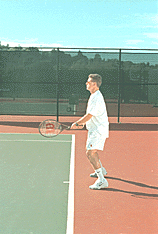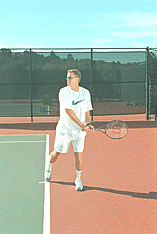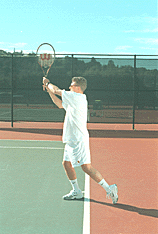By John Yandell
(Click
here to see a complete, animated sequence of the two-handed backhand
arm position.)
As with every shot in tennis the position of the racket head at the contact point is the critical element in the success (or failure) of the two-handed backhand stroke. Although it is never discussed in most tennis lessons, books, videos, etc., the position of the hitting arm in the course of the swing is what controls the position of the racket head at contact.
In the Visual Tennis system, the classic stroke models are based on simple hitting arm positions that remain constant throughout the course of the stroke. This ensures that the racket head is positioned correctly at contact, generating natural leverage from the body rotation and producing a stroke that is consistent and effortless.
A good two-handed classical backhand is bio-mechanically almost identical to the classical forehand. The back, left arm (for a right hander) drives the stroke. This dominant back arm is set in the hitting position at the completion of the turn. In this classic, or "double bend" hitting arm position, the elblow is bent and tucked in toward the waist and the wrist is laid back.
If you study high speed video of the best two-handers in the game, Andre Agassi, Michael Chang, Martina Hingis, and Mary Pierce, to name a few, you will see that all share this position in common throughout the course of the foreswing. Some top players wrap the finish. But high speed video shows this is a reaction and a relaxation response that happens only after the racket and hitting arm have passed through the finish position presented below.
A simple straight backswing is by far the cleanest way to achieve the correct hitting arm position at the completion of the turn. If you master the hitting arm position at the turn as described below, you will then naturally develop a compact, rhythmic, elipitcal shaped loop.
The key images below and the animation teach you how to establish this double bend hitting arm position and how to maintain it over the course of the swing.
For each position, establish the checkpoints physically. Now close your eyes and create an internal mental image of the position. Execute the entire swing pattern with your eyes closed. Let your internal imagery of the checkpoints guide the motion. The images of the hitting arm at each of the positions in the model can now function as keys to executing the stroke on the court. As the ball leaves your opponent's racket, visualize the image of the hitting arm position at the completion of the turn. Project the image into space behind you and let this serve as a mental blueprint. Now cover the blueprint with your actual arm and racket.
Now shift to the image of the contact and/or the finish. Again the projected image serves as a blueprint. Let your arm and racket pass through the image as you swing. Start in a controlled drill situation with an easy feed from a partner, teaching pro or ball machine, and work up to more difficult balls. The images give you a way to execute the stroke and stay positive under pressure.
The process of visualizing a key image can occur in the flash of a second--the time we actually have to hit a tennis ball. Using these images will give you an extremely reliable way to produce this classic hitting arm position even under competitive pressure.


Note the key checkpoints: The elbow on the top, dominant hand is relaxed and tucked in toward the side, almost touching the body. The wrist is laid back so that the tip of the racket is pointing to the back fence. The butt of the racket is "taking a picture" of the opponent.


- End of Part Seven -
Send email to the author
We encourage you to email your comments (pro, con, appreciative, whatever) directly to the author. To send email to John Yandell, click here.
To see John Yandell's Pro Tennis video series, go to: http://www.protennisvideo.com
Back to TennisONE Home Page
What's New | Tennis
Lessons | Tennis
in Your Area
Tennis Fitness | Tennis
Products | Sponsors/Advertisers/Consultants
TennisONE© is a trademark of TennisONE© and SportsWeb ONE©.
Copyright© 1995. All rights reserved.
<% ns_puts [nsv_get mkm_includes mkm_oldContentFooter_inc] %>